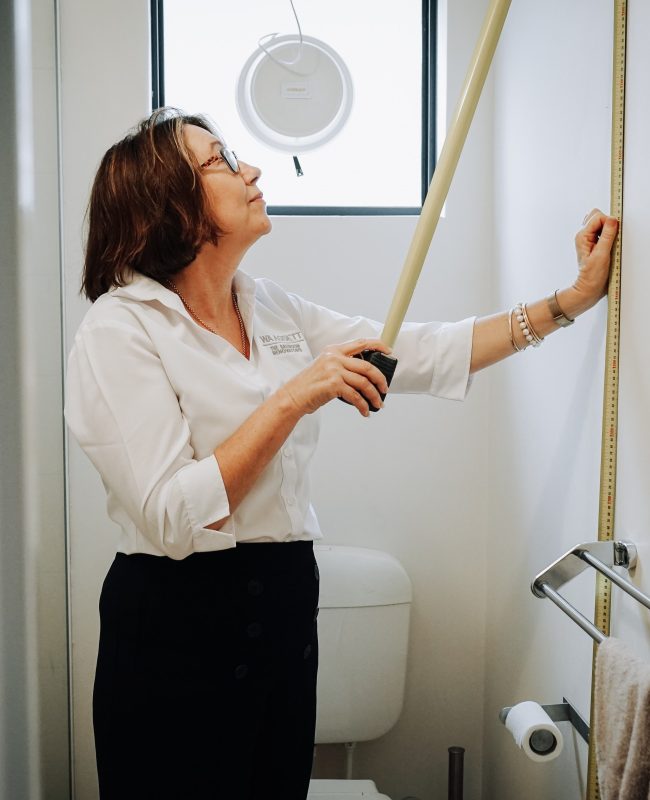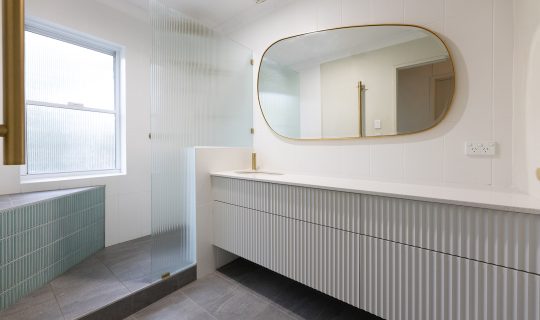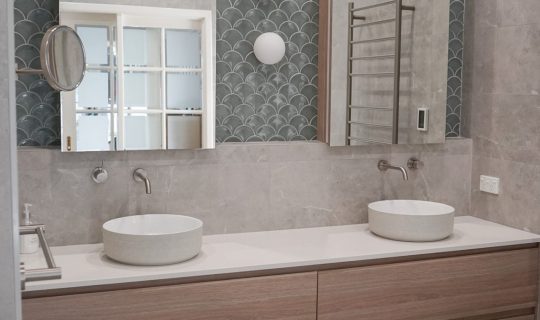Renovating your bathroom can be an exciting opportunity to create a space that’s both functional and stylish. But without the right planning and knowledge, it’s easy to fall into common traps—like underestimating timelines, overestimating your DIY abilities, or overlooking key design details. In this guide, we break down the most common bathroom renovation myths and mistakes in Australia and share expert tips to help your project run smoothly, stay within budget, and deliver lasting results
Renovating your bathroom can be exciting. There’s the promise of a new space that better suits your needs, and an updated style that’s going to last you into the future.
However, renovations are rarely straightforward, and it can be beneficial to navigate the common myths, fallacies, and mistakes that many homeowners in Australia often encounter. From underestimating the time and cost involved to falling victim to DIY shortcuts, these misconceptions can lead to frustration and unexpected expenses.
In this guide, we’ll break down the most prevalent bathroom renovation myths and mistakes in Australia and share practical advice on how to avoid them, ensuring your project runs as smoothly as possible and stays within budget.
Fallacy 1: “You Can Renovate Your Bathroom in a Week”
Whether due to misinformation or overpromising by unreliable contractors, many homeowners still believe a bathroom renovation can be completed in just a week—an expectation often fueled by fast-paced renovation shows like The Block, which tend to present unrealistic timelines. The reality, however, is that the process typically takes longer, often around 3-5 weeks, depending on the scope of the project. This includes demolition, plumbing, tiling, installation, and ensuring proper drying and curing times.
Rushing the renovation process to meet an unrealistic deadline can lead to subpar workmanship, mistakes, and costly repairs down the line. It is crucial to give each step of the renovation the time and care it deserves to ensure the final result is both functional and long-lasting. So, while it’s tempting to think a week is enough, it’s best to account for a longer (and more realistic) timeline to avoid cutting corners and achieving a truly beautiful and compliant bathroom.
Fallacy 2: “DIY Bathroom Renovations Will Save You Money”
Another prevalent myth surrounding bathroom renovations is that doing it yourself will always save you money. While it’s true that tackling simple tasks like painting or installing basic accessories might be manageable for some homeowners, more complex renovations require professional skills, particularly when dealing with plumbing, electrical work, and structural changes.
Undertaking a significant bathroom renovation without proper knowledge can result in a number of issues: damaged materials, badly designed spaces, unfinished work, or even breaches of Australian building codes. For example, improper plumbing installations can lead to leaks, which, if left undetected, could cause major water damage and mould growth. Similarly, electrical work that doesn’t meet safety standards can pose serious risks, including fire hazards.
Engaging licensed professionals—such as qualified plumbers, electricians, and tilers—not only helps ensure the job is done right the first time but can also save you money in the long run by avoiding costly rework. When these experts operate as a coordinated team, guided by a dedicated site supervisor who oversees the process and quality-checks all the pressure points as the renovation progresses, the project is far more likely to meet Australian building standards and deliver a high-quality, lasting result.
Cutting corners by DIY-ing your bathroom renovation may end up being more expensive and stressful than simply bringing in the pros in the first place.
Fallacy 3: “Small Bathrooms Can’t Be Luxurious”
Another common misconception is that small bathrooms can’t be luxurious or stylish. Many homeowners believe that limited space means they have to settle for basic, utilitarian designs rather than creating a bathroom that feels like a true retreat. However, this couldn’t be further from the truth. With the right design choices, even the smallest bathroom can exude sophistication and functionality.
The key to making a small bathroom feel luxurious lies in clever design and the use of high-quality materials. Smart storage solutions, such as wall-hung vanities, help maximise floor space while keeping the room neat and organised. Opting for premium fixtures—like elegant tapware, rain showerheads, or even a freestanding bathtub (if space permits)—can elevate the overall look without making the space feel cramped. Thoughtful lighting, including warm, dimmable lights or statement fittings, adds a touch of opulence. Wall-mounted accessories, such as toilet brush holders and shower shelves, can also contribute to a sleek, uncluttered aesthetic.
So, never let the size of your bathroom limit your vision. With the right design strategy, even the most compact spaces can become beautiful, functional, and luxurious retreats, perfect for unwinding after a long day.
And How About the Most Common Mistakes in Bathroom Renovation?
Now that you’ve navigated the myths and avoided the common pitfalls, it’s time to focus on the mistakes that many homeowners make during bathroom renovations. Even with the best intentions, these missteps can lead to delays, budget blowouts, and disappointing results. From failing to plan for proper ventilation to ignoring the importance of storage, there are several areas where things can go wrong.
In this section, we’ll highlight some of the most frequent mistakes people make during bathroom renovations and offer practical tips on how to avoid them, so your project stays on track and turns out just as you envisioned.
1. Rushing your planning
It should be an obvious one, but rushing into your bathroom renovations without a plan is a surefire way to end up with a bathroom that isn’t optimised for your needs.
It could be a space that isn’t laid out to provide optimal functionality, choosing materials that appear a different colour outside of the showroom, or not setting a clear timeline and letting the renovation drag out over weeks or months.
Creating a detailed plan ensures that you have a step-by-step guide for managing your renovation. It gives you the time and capability to map out everything you need, while ensuring you set a realistic budget and achievable timeline.
2. Neglecting good ventilation
Bathrooms are wet, steamy places, so good ventilation is critical. Poor ventilation can cause moisture to build up, leading to harmful mould, mildew, and moisture damage that gets worse over time.
Neglecting your ventilation is a big mistake when planning your bathroom renovation. To avoid it, be sure to invest in a high-quality exhaust fan. This one simple solution can help keep your bathroom looking and feeling better for longer.
3. Choosing the wrong materials for a bathroom
When undertaking your bathroom renovation, it’s crucial to choose the right materials. Not just for the aesthetics, but also for their durability and longevity.
Take paint, for example. Choose water-resistant paints that have been specially formulated for wet areas, to slow mould growth.
For your tiles, opt for strong, moisture-resistant tiles, like porcelain, that are designed to withstand the rigours of regular bathroom use, particularly humidity. Other types of tiles are more susceptible to water damage and premature ageing.
4. Ignoring good lighting design
We’ve all been in a bathroom with dim, unappealing lighting. It makes the bathroom feel cramped and uninviting. So it’s critical that you have the right lighting for your bathroom space.
As well as good general lighting, take task and accent lighting into account. Task lighting and accent lighting can play a big part in the functionality and style of your bathroom, particularly around your vanity. And be sure to speak with a qualified electrician about where the safest places are to install your new lights.
5. Focusing on current bathroom trends
Like fashion, bathroom trends come and go with the seasons. What’s trendy now may feel outdated in a few years, leaving you wanting to renovate again.
But updating your bathroom every season isn’t practical, or even possible.
So instead of choosing this season’s hottest bathroom trend, consider a timeless design for your bathroom renovation. One with a simple colour scheme and layout that provides the necessities you need. You can complement this with replaceable elements, like your tap fixtures, faucets, towel rails, and decor, which you can change as your taste does.
6. Overlooking storage needs
When planning your bathroom renovation, it’s important to take your storage needs into account. Not just for now, but also for the future.
After all, your needs may change. It could be a growing family or accommodating different bathroom routines. A good way to avoid this is by carefully planning your storage to make the best use of your available space, while also adding extra storage options.
Vanities with drawers rather than in-built shelves can maximise your available space. Hanging cabinets can make good use of wall space, or consider shower shelves that fit neatly into the spaces where you need them.
7. DIY-ing everything
There’s a sense of accomplishment about completing a DIY job. But you need to know your limits. Changing a faucet, replacing a tap, or installing a shelf is one thing, but if you aren’t experienced in bathroom renovations, there’s a lot that can go wrong.
Tasks like plumbing require precision, as even the smallest mistake can affect your bathroom’s functionality. Electrical work should always be carried out by a licensed electrician to ensure safety and compliance. It’s also crucial to prioritise proper waterproofing of the walls—this is often the biggest issue in bathrooms that haven’t been renovated correctly, leading to costly repairs down the track.
When planning a bathroom renovation, it’s best to engage a professional from the outset. Their experience not only ensures a higher-quality finish—often faster and cleaner than a typical DIY effort—but also means they’re well-equipped to handle any unexpected issues that may arise during the project.
8. Poor layout decisions
A bathroom should be a place where you can relax. It should make your daily routine easier.
A poorly designed bathroom can feel cramped and make things inconvenient to use. So when designing your new bathroom, prioritise functionality first, then looks.
Leave enough room between each area and feature that you use, but not too much. Make sure that the toilet, sink, and shower are all easily accessible, and cupboard or bathroom doors don’t restrict use. And place your taps and faucets where they’re easy to access, without having to reach through the water stream when turning on the shower.
9. Underestimating your budget
When planning a bathroom renovation, it’s crucial to have a realistic budget in mind. Running out of funds midway through your project isn’t fun. It can leave your project sitting unfinished for months on end or cause you to sacrifice quality for cost.
It’s important to set a realistic budget from the start. Calculate all your prices at the outset, and build enough fat into your budget for those unexpected costs that can crop up.
10. Forgetting accessibility
Just because you don’t need it now doesn’t mean that you shouldn’t include accessibility in your bathroom design.
Planning for the future means you can continue using your bathroom comfortably as you get older. There could be a time when ageing family members share your bathroom, or you have a friend or colleague over with mobility needs.
Consider hardware like grab bars and adjustable shower heads—or include the space to add them at a later date. Also consider a walk-in shower, which makes it easier for everyone to use.
WA Assett helps you avoid these bathroom renovation mistakes
With the right guidance, advice, and support, you can avoid these common bathroom renovation mistakes, resulting in a bathroom that you love and enjoy for years to come.
Contact our team for a complimentary in-home consultation and estimate to discuss plans for your bathroom renovation.




